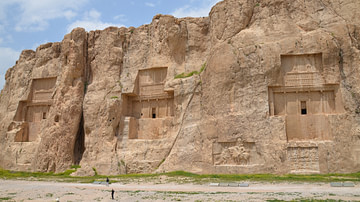Review

| Rating: | |
|---|---|
| Title: | From Cyrus to Alexander: A History of the Persian Empire |
| Author: | Pierre Briant |
| Audience: | General Public |
| Difficulty: | Medium |
| Publisher: | Eisenbrauns |
| Published: | 2002 |
| Pages: | 1216 |
"From Cyrus to Alexander" by Pierre Briant offers a detailed history of the Persian Empire, focusing on its administration, culture, and military. Briant highlights Persia’s innovations in governance and its tolerant, multicultural approach. The book challenges traditional Greek-centric views, presenting Persia as a complex and influential empire with a lasting historical legacy.
Pierre Briant’s From Cyrus to Alexander: A History of the Persian Empire is widely considered the definitive modern history of the Persian Empire. The book covers its origins under Cyrus the Great through its conquest by Alexander the Great. Originally published in French as Histoire de l’Empire Perse in 1996, the English translation made this monumental work accessible to a wider audience, expanding its influence in Near Eastern studies, ancient history, and comparative empires.
Briant’s book stands out for its focus on presenting the Persian Empire as an autonomous civilization rather than through the perspective of its Greek rivals. Historically, much of what Western scholars knew about the Persian Empire came from Greek sources like Herodotus, who often cast Persia as a monolithic enemy. By situating Persia at the center of its own narrative and making extensive use of archaeological findings, inscriptions, and administrative records, Briant counters this Eurocentric bias and offers a view of Persia as a sophisticated, multiethnic empire that left a significant legacy of governance, culture, and trade.
Briant structures the book in a way that mirrors the breadth of the Persian Empire, dedicating each section to a different aspect of the empire’s history, politics, economy, society, and culture. The organisation of the book reflects his emphasis on a systemic, comprehensive examination of the empire.
The early chapters detail Cyrus the Great’s conquests and policies of tolerance, which established a stable, expansive empire. Briant also examines governance, highlighting the balance between central control and local autonomy, the role of satraps, and the unifying use of Aramaic as an administrative lingua franca. Moreover, he analyses the Persian military apparatus, from its elite units like the Immortals to the logistical organisation enabling vast mobilizations by the Persians. He contextualises major conflicts, including the Persian Wars as part of a strategy to stabilize borders and secure valuable territories, rather than dominate all of Greece.
The book also dedicates significant attention to the Persian economy, exploring the empire’s agrarian base, trade networks, and taxation system. He shows how Persia’s economic policies were designed to support both the imperial treasury and local economies, creating a sustainable model that contributed to the empire’s longevity. The culture and religion section highlights Persia’s promotion of cultural integration and religious diversity. Briant shows how Persian art blended regional styles to symbolize royal authority and examines how Zoroastrian traditions coexisted with support for local religions, fostering loyalty among subjects.
One of Briant’s central arguments is that the Persian Empire’s strength lay in its policy of tolerance and inclusion. By allowing conquered peoples to retain their religious practices, local laws, and leaders, the Persians created a sense of allegiance that went beyond military domination. He also highlights the Persian administrative system as a model for later empires, like the Roman and Islamic. Innovations such as standardized taxation, the Royal Road, and an organised postal system enabled centralised yet flexible governance. His analysis of satrapies shows how Persia balanced regional autonomy with loyalty to central authority.
The book repositions the Persian Empire within a global context, highlighting its role in economic and cultural exchange across Asia and the Mediterranean. Through trade and diplomacy with regions like Egypt and Greece, Persia facilitated the flow of ideas and technologies, serving as a prototype for managing diverse populations and complex trade networks.
From Cyrus to Alexander is widely praised for its depth but critiqued for its daunting length and scholarly density. While excelling in its analysis of Persian administration and politics, it offers limited insight into the daily lives of ordinary Persians, focusing more on imperial strategies than social and cultural history.
This monumental work offers a detailed and balanced account of the Persian Empire, redefining its role in world history. Briant’s focus on understanding Persia on its own terms provides valuable insights into its governance, economy, and cultural integration, making it an essential resource for ancient Near Eastern studies.
About the Reviewer
Cite This Work
APA Style
Panagi, K. (2024, December 11). From Cyrus to Alexander: A History of the Persian Empire. World History Encyclopedia. Retrieved from https://www.worldhistory.org/review/496/from-cyrus-to-alexander-a-history-of-the-persian-e/
Chicago Style
Panagi, Katerina. "From Cyrus to Alexander: A History of the Persian Empire." World History Encyclopedia. Last modified December 11, 2024. https://www.worldhistory.org/review/496/from-cyrus-to-alexander-a-history-of-the-persian-e/.
MLA Style
Panagi, Katerina. "From Cyrus to Alexander: A History of the Persian Empire." World History Encyclopedia. World History Encyclopedia, 11 Dec 2024, https://www.worldhistory.org/review/496/from-cyrus-to-alexander-a-history-of-the-persian-e/. Web. 23 Apr 2025.




